Abstract
Maternal, cord and infant measles antibody levels were measured and compared in a group of 411 vaccinated mothers and 240 unvaccinated mothers, and their babies, between 1983 and 1991. Maternal and cord sera were tested by haemagglutination inhibition and/or enzyme-linked immunosorbent assay, and plaque reduction neutralization tests were also used to test infant sera. Geometric mean titres were significantly higher in the unvaccinated than in the vaccinated mothers (P < 0.001). Infants born to mothers with a history of measles had higher antibody levels at birth than infants of vaccinated mothers and, although the difference narrowed over time, continued to have higher levels up to 30 weeks of age. Between 5 and 7 months of age significantly more of the children of vaccinated mothers had plaque reduction neutralization antibody levels below that which would interfere with vaccination. As the boosting effect of circulating natural measles disappears, earlier measles vaccination may need to be considered, perhaps as part of a two-dose policy.
Full text
PDF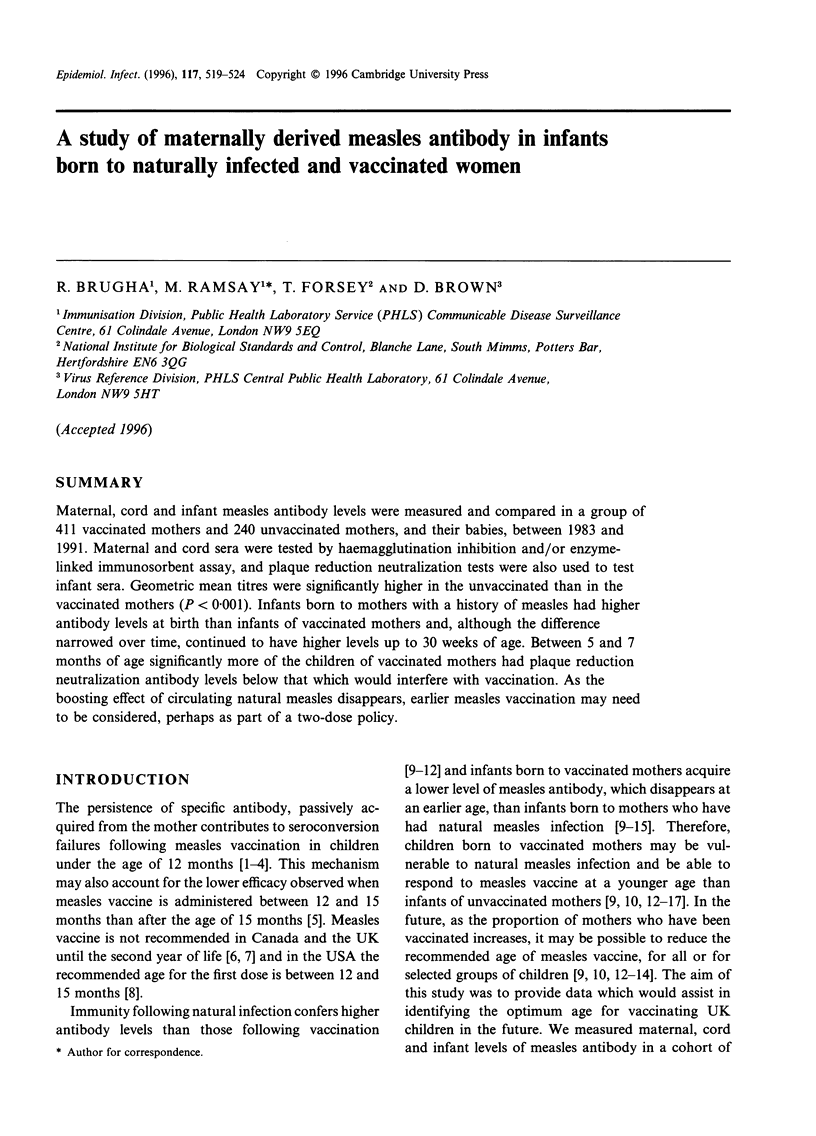
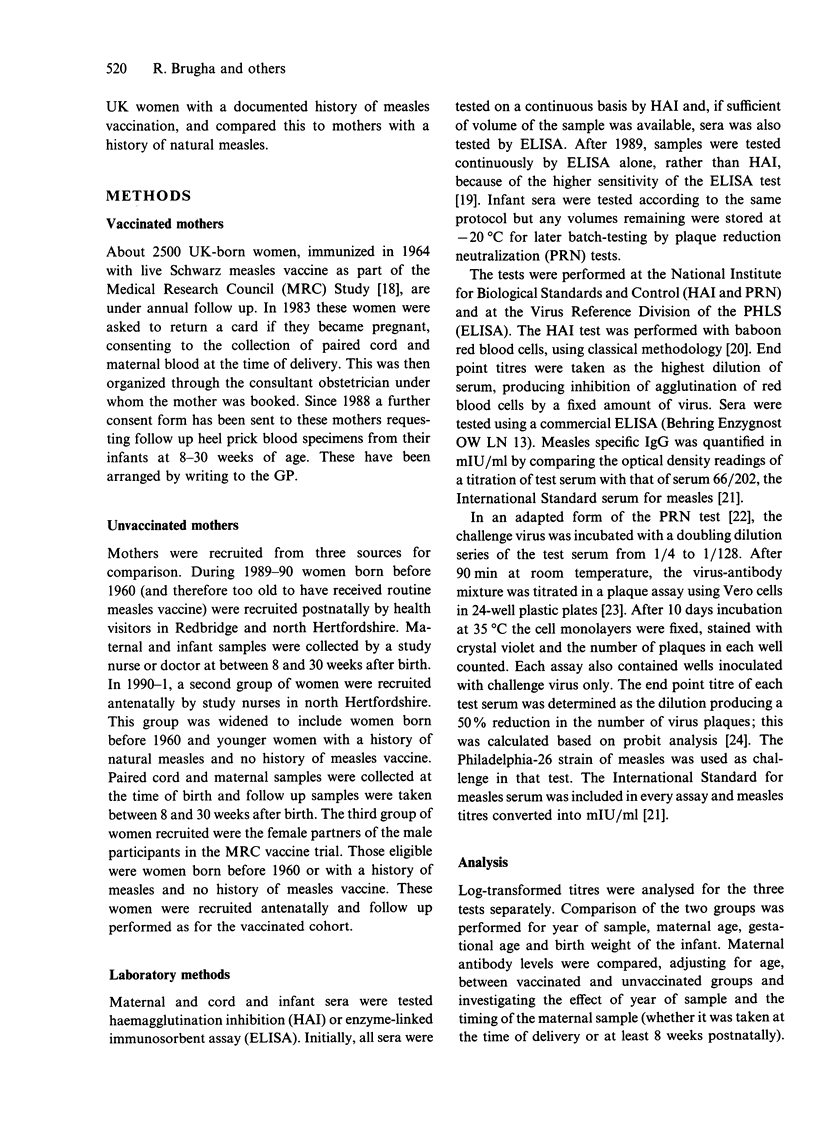
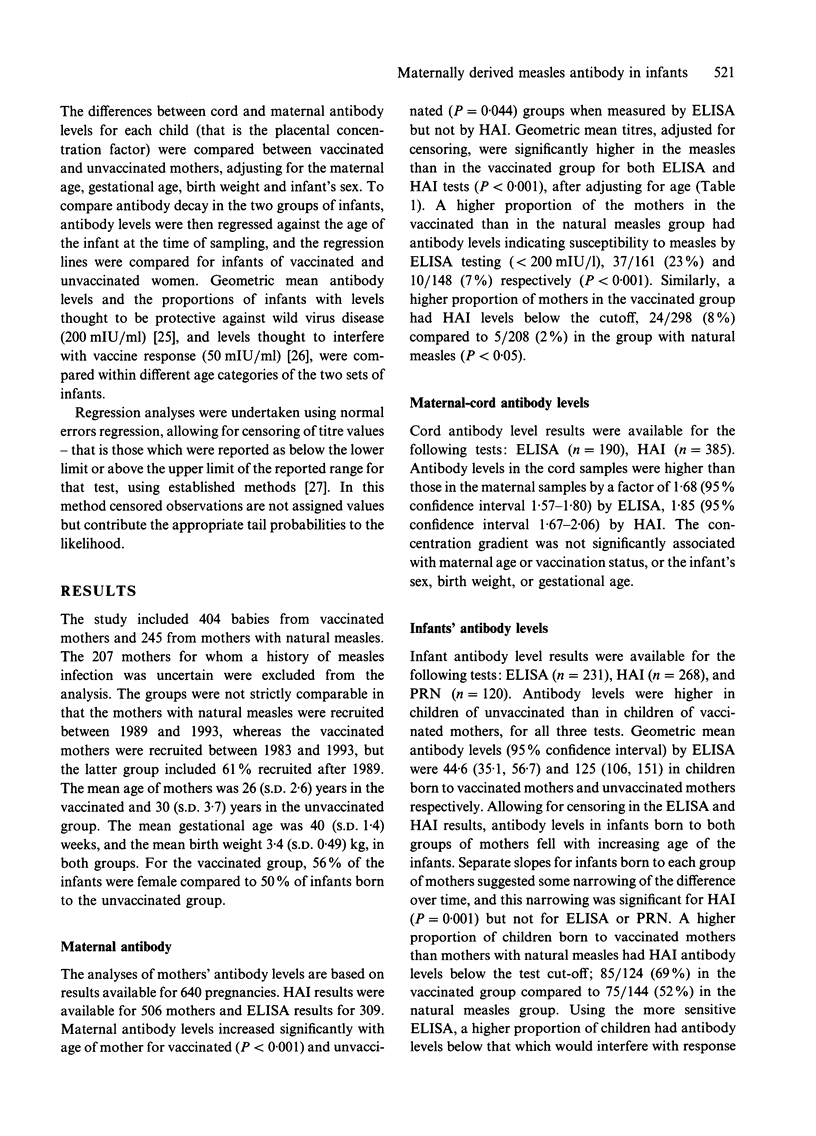
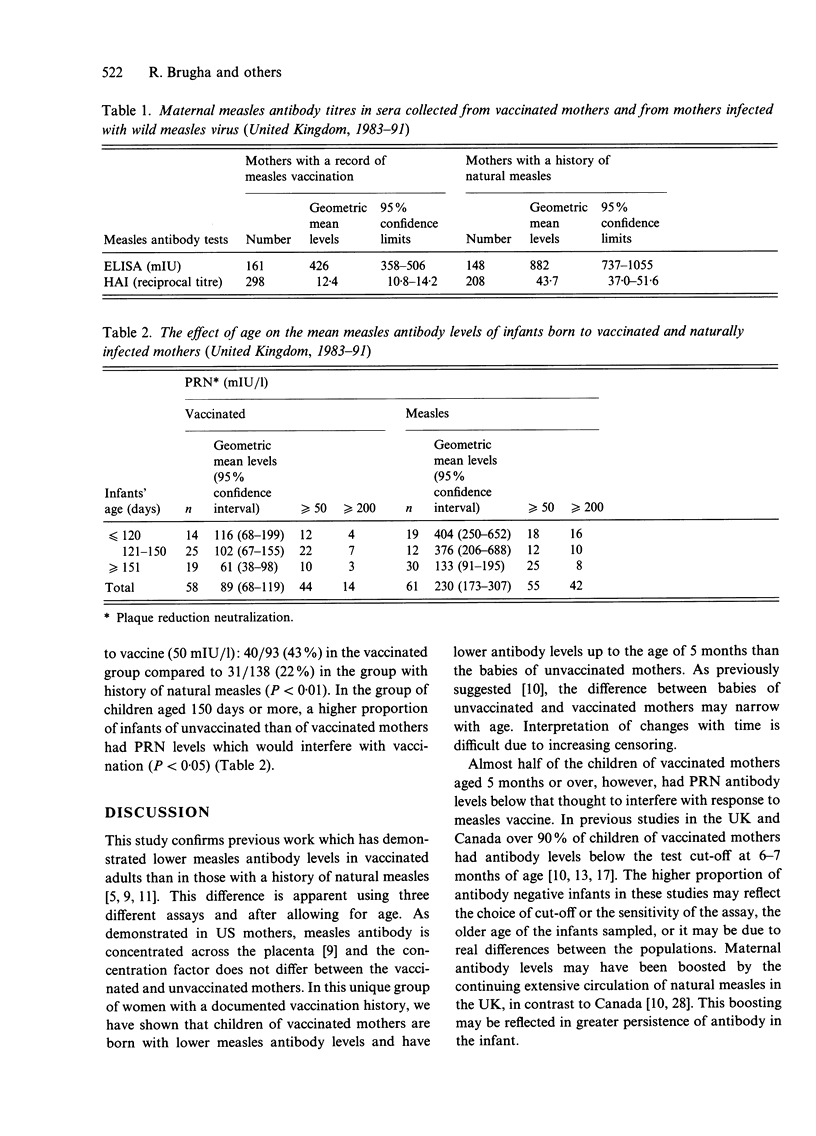
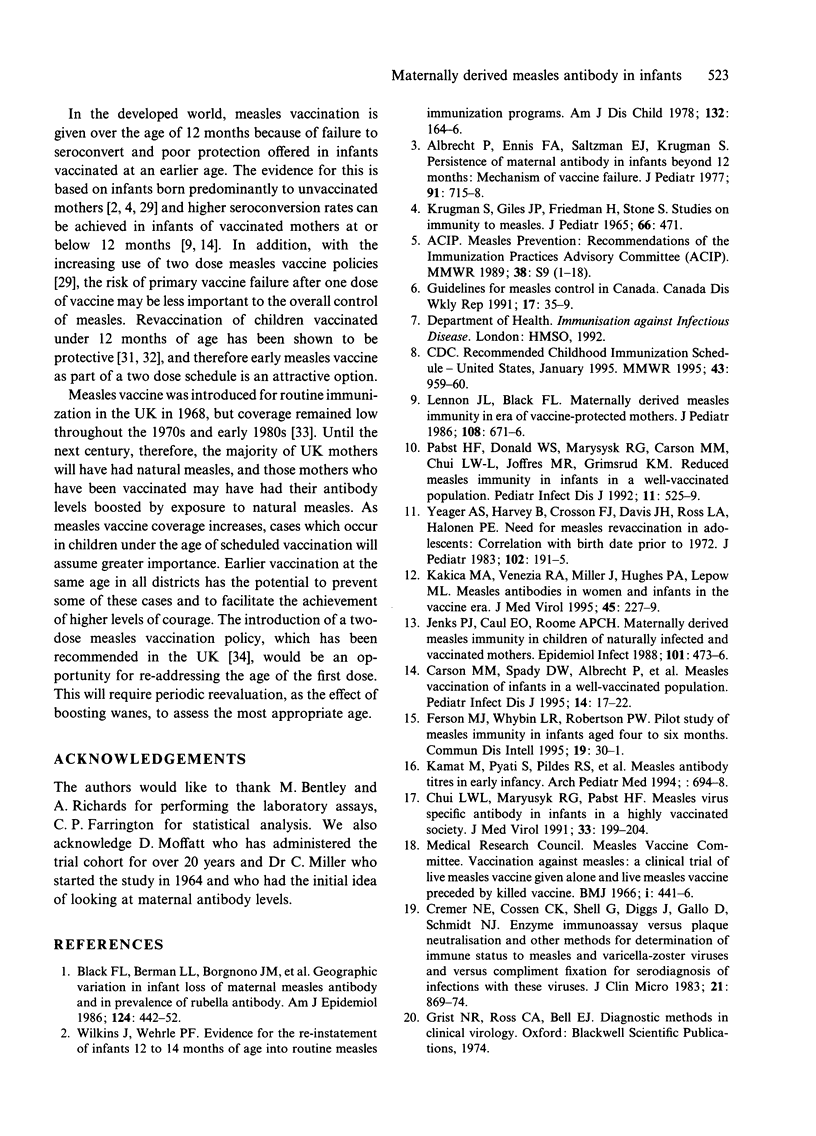
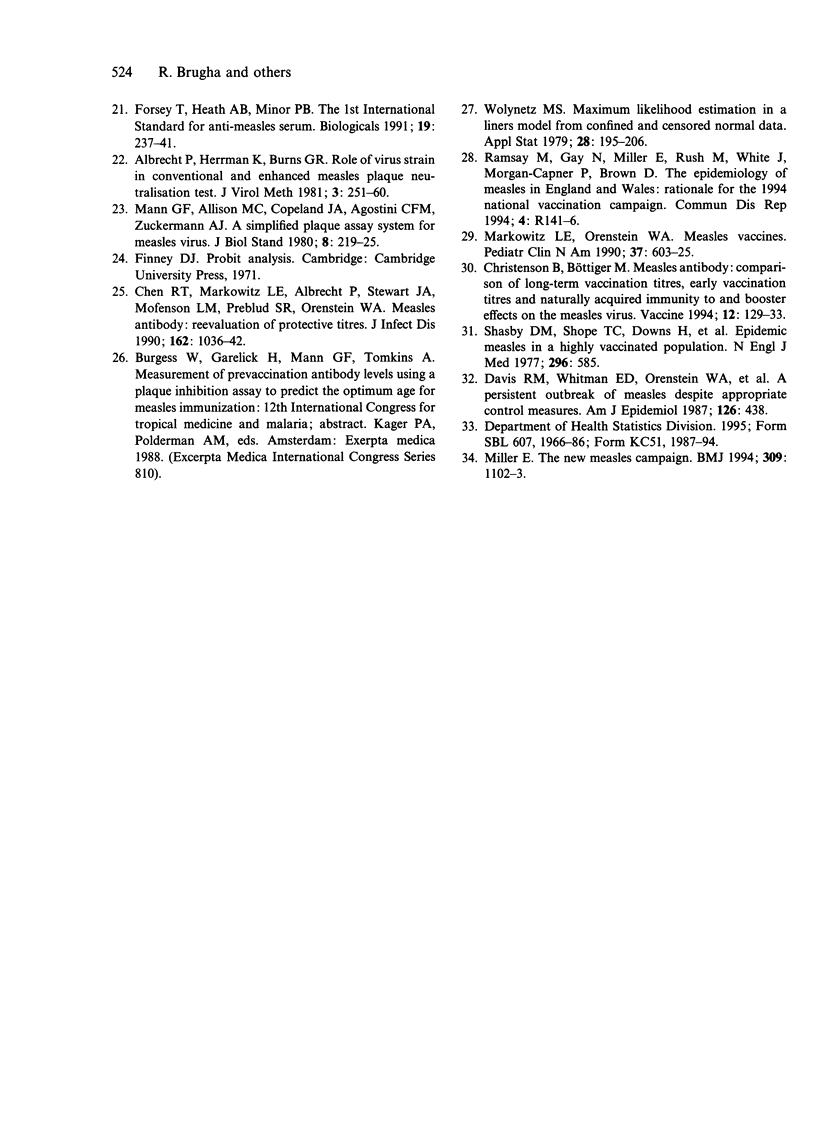
Selected References
These references are in PubMed. This may not be the complete list of references from this article.
- Albrecht P., Ennis F. A., Saltzman E. J., Krugman S. Persistence of maternal antibody in infants beyond 12 months: mechanism of measles vaccine failure. J Pediatr. 1977 Nov;91(5):715–718. doi: 10.1016/s0022-3476(77)81021-4. [DOI] [PubMed] [Google Scholar]
- Albrecht P., Herrmann K., Burns G. R. Role of virus strain in conventional and enhanced measles plaque neutralization test. J Virol Methods. 1981 Dec;3(5):251–260. doi: 10.1016/0166-0934(81)90062-8. [DOI] [PubMed] [Google Scholar]
- Black F. L., Berman L. L., Borgoño J. M., Capper R. A., Carvalho A. A., Collins C., Glover O., Hijazi Z., Jacobson D. L., Lee Y. L. Geographic variation in infant loss of maternal measles antibody and in prevalence of rubella antibody. Am J Epidemiol. 1986 Sep;124(3):442–452. doi: 10.1093/oxfordjournals.aje.a114415. [DOI] [PubMed] [Google Scholar]
- Carson M. M., Spady D. W., Albrecht P., Beeler J. A., Thipphawong J., Barreto L., Grimsrud K. M., Pabst H. F. Measles vaccination of infants in a well-vaccinated population. Pediatr Infect Dis J. 1995 Jan;14(1):17–22. doi: 10.1097/00006454-199501000-00003. [DOI] [PubMed] [Google Scholar]
- Centers for Disease Control and Prevention (CDC) Recommended childhood immunization schedule--United States, January 1995. Advisory Committee on Immunization Practices. American Academy of Pediatrics. American Academy of Family Physicians. National Immunization Program, CDC. MMWR Morb Mortal Wkly Rep. 1995 Jan 6;43(51-52):959–960. [PubMed] [Google Scholar]
- Chen R. T., Markowitz L. E., Albrecht P., Stewart J. A., Mofenson L. M., Preblud S. R., Orenstein W. A. Measles antibody: reevaluation of protective titers. J Infect Dis. 1990 Nov;162(5):1036–1042. doi: 10.1093/infdis/162.5.1036. [DOI] [PubMed] [Google Scholar]
- Christenson B., Böttiger M. Measles antibody: comparison of long-term vaccination titres, early vaccination titres and naturally acquired immunity to and booster effects on the measles virus. Vaccine. 1994 Feb;12(2):129–133. doi: 10.1016/0264-410x(94)90049-3. [DOI] [PubMed] [Google Scholar]
- Chui L. W., Marusyk R. G., Pabst H. F. Measles virus specific antibody in infants in a highly vaccinated society. J Med Virol. 1991 Mar;33(3):199–204. doi: 10.1002/jmv.1890330311. [DOI] [PubMed] [Google Scholar]
- Cremer N. E., Cossen C. K., Shell G., Diggs J., Gallo D., Schmidt N. J. Enzyme immunoassay versus plaque neutralization and other methods for determination of immune status to measles and varicella-zoster viruses and versus complement fixation for serodiagnosis of infections with those viruses. J Clin Microbiol. 1985 Jun;21(6):869–874. doi: 10.1128/jcm.21.6.869-874.1985. [DOI] [PMC free article] [PubMed] [Google Scholar]
- Davis R. M., Whitman E. D., Orenstein W. A., Preblud S. R., Markowitz L. E., Hinman A. R. A persistent outbreak of measles despite appropriate prevention and control measures. Am J Epidemiol. 1987 Sep;126(3):438–449. doi: 10.1093/oxfordjournals.aje.a114675. [DOI] [PubMed] [Google Scholar]
- Forsey T., Heath A. B., Minor P. D. The 1st International Standard for anti-measles serum. Biologicals. 1991 Jul;19(3):237–241. doi: 10.1016/1045-1056(91)90042-i. [DOI] [PubMed] [Google Scholar]
- Jenks P. J., Caul E. O., Roome A. P. Maternally derived measles immunity in children of naturally infected and vaccinated mothers. Epidemiol Infect. 1988 Oct;101(2):473–476. doi: 10.1017/s095026880005442x. [DOI] [PMC free article] [PubMed] [Google Scholar]
- KRUGMAN S., GILES J. P., FRIEDMAN H., STONE S. STUDIES ON IMMUNITY TO MEASLES. J Pediatr. 1965 Mar;66:471–488. doi: 10.1016/s0022-3476(65)80112-3. [DOI] [PubMed] [Google Scholar]
- Kacica M. A., Venezia R. A., Miller J., Hughes P. A., Lepow M. L. Measles antibodies in women and infants in the vaccine era. J Med Virol. 1995 Feb;45(2):227–229. doi: 10.1002/jmv.1890450220. [DOI] [PubMed] [Google Scholar]
- Kamat M., Pyati S., Pildes R. S., Jacobs N., Luayon M., Muldoon R., Levy P. S. Measles antibody titers in early infancy. Arch Pediatr Adolesc Med. 1994 Jul;148(7):694–698. doi: 10.1001/archpedi.1994.02170070032005. [DOI] [PubMed] [Google Scholar]
- Lennon J. L., Black F. L. Maternally derived measles immunity in era of vaccine-protected mothers. J Pediatr. 1986 May;108(5 Pt 1):671–676. doi: 10.1016/s0022-3476(86)81039-3. [DOI] [PubMed] [Google Scholar]
- Mann G. F., Allison L. M., Copeland J. A., Agostini C. F., Zuckerman A. J. A simplified plaque assay system for measles virus. J Biol Stand. 1980;8(3):219–225. doi: 10.1016/s0092-1157(80)80037-0. [DOI] [PubMed] [Google Scholar]
- Markowitz L. E., Orenstein W. A. Measles vaccines. Pediatr Clin North Am. 1990 Jun;37(3):603–625. doi: 10.1016/s0031-3955(16)36907-3. [DOI] [PubMed] [Google Scholar]
- Miller E. The new measles campaign. BMJ. 1994 Oct 29;309(6962):1102–1103. doi: 10.1136/bmj.309.6962.1102. [DOI] [PMC free article] [PubMed] [Google Scholar]
- Pabst H. F., Spady D. W., Marusyk R. G., Carson M. M., Chui L. W., Joffres M. R., Grimsrud K. M. Reduced measles immunity in infants in a well-vaccinated population. Pediatr Infect Dis J. 1992 Jul;11(7):525–529. doi: 10.1097/00006454-199207000-00004. [DOI] [PubMed] [Google Scholar]
- Ramsay M., Gay N., Miller E., Rush M., White J., Morgan-Capner P., Brown D. The epidemiology of measles in England and Wales: rationale for the 1994 national vaccination campaign. Commun Dis Rep CDR Rev. 1994 Nov 11;4(12):R141–R146. [PubMed] [Google Scholar]
- Shasby D. M., Shope T. C., Downs H., Herrmann K. L., Polkowski J. Epidemic measles in a highly vaccinated population. N Engl J Med. 1977 Mar 17;296(11):585–589. doi: 10.1056/NEJM197703172961102. [DOI] [PubMed] [Google Scholar]
- Wilkins J., Wehrle P. F. Evidence for reinstatement of infants 12 to 14 months of age into routine measles immunization programs. Am J Dis Child. 1978 Feb;132(2):164–166. doi: 10.1001/archpedi.1978.02120270062013. [DOI] [PubMed] [Google Scholar]
- Yeager A. S., Harvey B., Crosson F. J., Jr, Davis J. H., Ross L. A., Halonen P. E. Need for measles revaccination in adolescents: correlation with birth date prior to 1972. J Pediatr. 1983 Feb;102(2):191–195. doi: 10.1016/s0022-3476(83)80517-4. [DOI] [PubMed] [Google Scholar]


